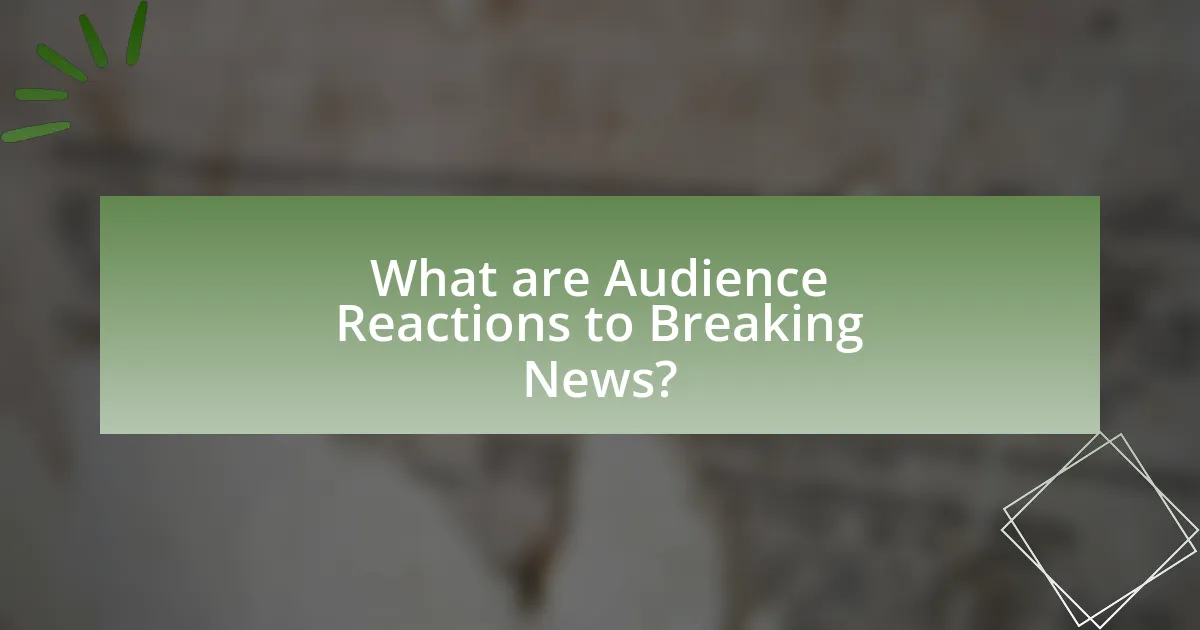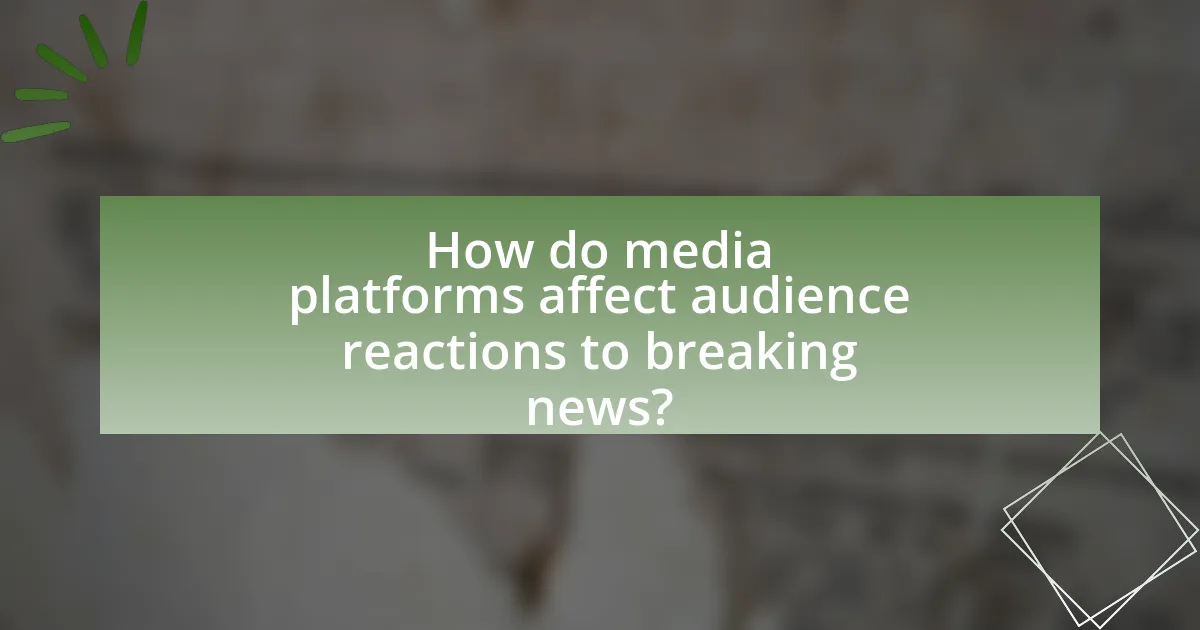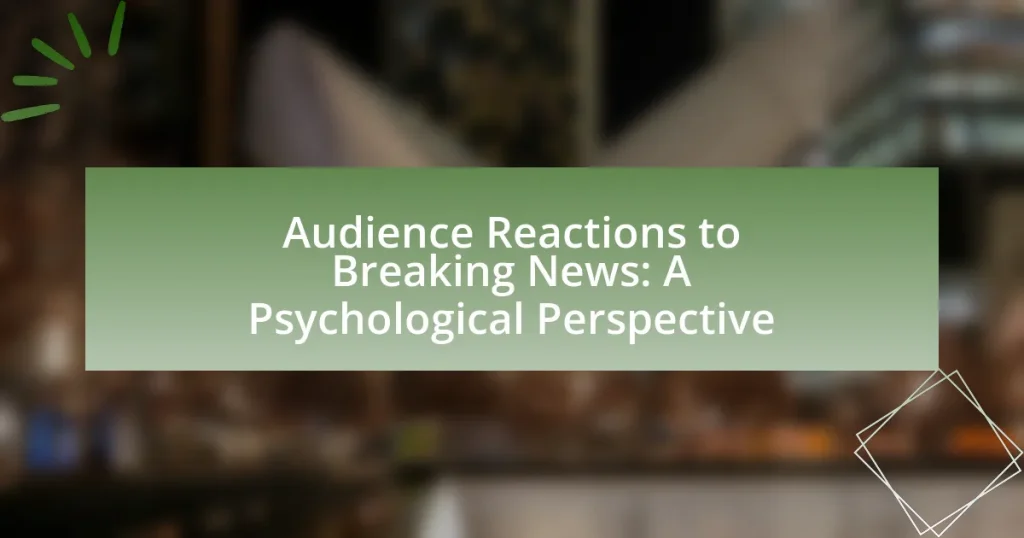The article examines audience reactions to breaking news through a psychological lens, highlighting the emotional responses such as shock, anxiety, and anger that often accompany such events. It discusses how psychological factors, including cognitive processing and prior knowledge, shape these reactions and influence the interpretation of news. The role of emotions in audience engagement, the impact of different media platforms, and demographic variations in responses are also explored. Additionally, the article emphasizes the importance of understanding audience reactions for news organizations to enhance credibility and effectively communicate breaking news.

What are Audience Reactions to Breaking News?
Audience reactions to breaking news typically include heightened emotional responses, such as shock, anxiety, or anger. Research indicates that these reactions are influenced by factors like the nature of the news, individual psychological traits, and social context. For instance, a study published in the Journal of Communication found that breaking news events can trigger immediate emotional responses, leading to increased engagement with media and discussions among peers. This engagement often reflects a desire for information and understanding, as audiences seek to process the implications of the news.
How do psychological factors influence audience reactions to breaking news?
Psychological factors significantly influence audience reactions to breaking news by shaping perceptions, emotions, and cognitive processing. For instance, the framing of news can evoke different emotional responses; a report emphasizing fear may lead to heightened anxiety, while one focusing on hope can foster resilience. Research indicates that cognitive biases, such as confirmation bias, cause individuals to interpret news in a way that aligns with their pre-existing beliefs, affecting their overall reaction. Additionally, social identity theory suggests that individuals may react more strongly to news that pertains to their in-group, leading to polarized responses. These psychological mechanisms demonstrate how audience reactions are not solely based on the content of the news but are deeply intertwined with individual and collective psychological processes.
What role do emotions play in shaping audience responses?
Emotions significantly influence audience responses by affecting attention, memory, and decision-making processes. Research indicates that emotionally charged content captures attention more effectively, leading to increased engagement and retention of information. For instance, a study published in the journal “Emotion” by Paul Ekman demonstrates that emotional stimuli can enhance memory recall, suggesting that audiences are more likely to remember news stories that evoke strong feelings such as fear or joy. Additionally, emotions can drive individuals to share content, as evidenced by findings from the Pew Research Center, which show that emotionally resonant news articles are more likely to be shared on social media platforms. Thus, emotions play a crucial role in shaping how audiences perceive, remember, and react to news.
How does cognitive processing affect the interpretation of breaking news?
Cognitive processing significantly influences how individuals interpret breaking news by shaping their understanding and emotional responses to the information presented. When people encounter breaking news, their cognitive frameworks, including prior knowledge, biases, and emotional states, determine how they perceive and evaluate the information. For instance, research indicates that individuals with strong pre-existing beliefs may engage in confirmation bias, selectively interpreting news to align with their views, which can distort their understanding of the event (Nickerson, 1998). Additionally, cognitive load affects how well individuals can process complex information; when news is presented in a fast-paced manner, as is typical with breaking news, cognitive overload can lead to misinterpretation or oversimplification of the facts (Sweller, 1988). Thus, cognitive processing plays a crucial role in shaping the interpretation of breaking news, influencing both comprehension and emotional reactions.
Why is understanding audience reactions important for news media?
Understanding audience reactions is crucial for news media because it directly influences content creation and dissemination strategies. By analyzing audience feedback, news organizations can tailor their reporting to meet the interests and emotional responses of their viewers, thereby enhancing engagement and trust. Research indicates that audience reactions can significantly affect the perceived credibility of news sources; for instance, a study by the Pew Research Center found that 62% of Americans believe that news organizations should consider audience feedback when reporting. This demonstrates that understanding audience reactions not only shapes the narrative but also impacts the overall effectiveness of communication in the media landscape.
How can audience reactions impact news dissemination and credibility?
Audience reactions significantly impact news dissemination and credibility by influencing how information is shared and perceived. When audiences engage positively with news content, such as through likes, shares, or comments, it increases the visibility of that content across social media platforms, leading to wider dissemination. Conversely, negative reactions can lead to decreased visibility and credibility, as audiences may question the reliability of the source. Research indicates that news articles with higher engagement rates are often perceived as more credible, as demonstrated in a study by Vosoughi, Roy, and Aral (2018) published in Science, which found that false news spreads more slowly than true news, but when it does, it often garners more attention due to audience reactions. Thus, audience engagement directly correlates with the credibility and reach of news stories.
What are the implications for journalists and news organizations?
The implications for journalists and news organizations include the necessity to adapt their reporting strategies to align with audience expectations and psychological responses to breaking news. As audiences increasingly seek immediate and engaging content, journalists must prioritize accuracy and context to maintain credibility while also addressing the emotional and cognitive reactions of their audience. Research indicates that audiences often experience heightened anxiety and urgency during breaking news events, which can influence their information-seeking behavior and trust in media sources. Therefore, journalists and news organizations must balance the speed of reporting with thorough fact-checking and responsible storytelling to foster trust and engagement.

What types of audience reactions are observed in breaking news scenarios?
In breaking news scenarios, audience reactions typically include shock, anxiety, confusion, and a desire for information. Research indicates that these emotional responses are often triggered by the unexpected nature of breaking news events, which can lead to heightened stress levels and a need for immediate updates. For instance, a study published in the Journal of Communication found that individuals exposed to sudden, alarming news reported increased feelings of uncertainty and a compulsion to seek further details to alleviate their anxiety. This illustrates how the immediacy and unpredictability of breaking news can significantly impact audience emotions and behaviors.
How do different demographics respond to breaking news?
Different demographics respond to breaking news in varied ways, influenced by factors such as age, education, and cultural background. For instance, younger audiences tend to rely on social media platforms for real-time updates, while older demographics often prefer traditional news outlets like television or newspapers. Research indicates that individuals with higher education levels are more likely to seek out diverse sources for information, leading to a more nuanced understanding of breaking news events. Additionally, cultural background can shape emotional responses; for example, individuals from collectivist cultures may prioritize community impact in their reactions, whereas those from individualistic cultures might focus on personal implications. These differences highlight the importance of tailoring news delivery to effectively engage diverse audience segments.
What differences exist in reactions based on age, gender, or cultural background?
Reactions to breaking news differ significantly based on age, gender, and cultural background. Research indicates that younger individuals often exhibit more emotional responses and are more likely to share news on social media, while older adults tend to process information more critically and may prioritize factual accuracy over emotional engagement. Gender differences reveal that women generally express more empathy and emotional reactions to news stories, whereas men may focus more on the factual content and implications. Cultural background influences reactions as well; for instance, collectivist cultures may emphasize community impact and shared emotional responses, while individualistic cultures often highlight personal relevance and individual perspectives. These differences are supported by studies such as “The Role of Age and Gender in Emotional Reactions to News” published in the Journal of Communication, which found that demographic factors significantly shape how individuals engage with news content.
How does prior knowledge influence audience reactions?
Prior knowledge significantly influences audience reactions by shaping their interpretation and emotional response to information. Individuals with extensive background knowledge on a topic are more likely to critically evaluate new information, leading to nuanced understanding and potentially stronger emotional reactions. For instance, research by Kintsch and van Dijk (1978) highlights that prior knowledge facilitates comprehension and retention of new information, allowing audiences to connect it with existing mental frameworks. This connection can result in heightened engagement or skepticism, depending on how the new information aligns with their pre-existing beliefs.
What are common emotional responses to breaking news?
Common emotional responses to breaking news include shock, anxiety, anger, and sadness. These reactions often stem from the unexpected nature of the news and its potential impact on individuals and communities. Research indicates that exposure to distressing news can trigger a fight-or-flight response, leading to heightened anxiety and fear. For instance, a study published in the journal “Psychological Science” found that individuals exposed to negative news reported increased feelings of helplessness and distress. Additionally, anger may arise from perceived injustices or frustrations related to the news content, while sadness often reflects empathy for those affected by the events reported.
How do fear and anxiety manifest in audience reactions?
Fear and anxiety manifest in audience reactions through physiological responses, behavioral changes, and emotional expressions. Audiences may exhibit increased heart rates, sweating, or shallow breathing, indicating heightened arousal due to fear or anxiety. Behaviorally, individuals might withdraw, avoid eye contact, or display fidgeting, reflecting discomfort or distress. Emotionally, reactions can include panic, confusion, or heightened vigilance, as seen in studies where breaking news triggers immediate fear responses, leading to a collective sense of unease. Research by the American Psychological Association highlights that exposure to distressing news can amplify anxiety levels, demonstrating a direct correlation between media content and audience emotional states.
What role does empathy play in audience engagement with breaking news?
Empathy significantly enhances audience engagement with breaking news by fostering emotional connections to the stories presented. When news outlets convey stories that evoke empathy, audiences are more likely to feel a personal stake in the events, leading to increased attention and sharing of the news. Research indicates that empathetic responses can amplify the perceived relevance of news content, making individuals more likely to engage with it on social media platforms. For instance, a study published in the journal “Communication Research” found that emotionally charged news stories that elicit empathy result in higher levels of audience interaction and discussion. This demonstrates that empathy not only drives engagement but also shapes how audiences process and respond to breaking news.

How do media platforms affect audience reactions to breaking news?
Media platforms significantly influence audience reactions to breaking news by shaping the speed, framing, and accessibility of information. For instance, social media platforms like Twitter and Facebook allow for real-time updates, which can lead to immediate emotional responses from users, often driven by the urgency of the information presented. Research indicates that the framing of news—how information is presented—can alter perceptions and emotional reactions; for example, a study published in the Journal of Communication found that emotionally charged headlines can increase engagement and sharing among audiences. Additionally, the accessibility of news on various platforms can create echo chambers, where audiences are exposed primarily to viewpoints that reinforce their existing beliefs, further intensifying their reactions.
What differences exist between traditional and digital media in audience reactions?
Traditional media typically elicits more passive audience reactions, while digital media encourages active engagement. In traditional media, such as television and newspapers, audiences receive information in a one-way communication format, leading to limited interaction and feedback. In contrast, digital media platforms, like social media and news websites, allow for real-time comments, shares, and discussions, fostering a more interactive experience. Research indicates that 62% of social media users engage with news content by sharing or commenting, highlighting the participatory nature of digital media compared to the passive consumption of traditional outlets.
How does the speed of information delivery impact audience emotions?
The speed of information delivery significantly impacts audience emotions by intensifying their emotional responses. Rapid dissemination of news can lead to heightened feelings of anxiety, urgency, and fear, as audiences may feel overwhelmed by the immediacy of events. Research indicates that when information is delivered quickly, individuals often experience a sense of loss of control, which can exacerbate negative emotions. For instance, a study published in the journal “Communication Research” by researchers at the University of Pennsylvania found that fast-paced news updates during crises increased stress levels among viewers, demonstrating a direct correlation between speed and emotional intensity.
What are the effects of social media on audience engagement with breaking news?
Social media significantly enhances audience engagement with breaking news by facilitating real-time information sharing and interaction. Platforms like Twitter and Facebook allow users to receive updates instantly, comment on stories, and share their perspectives, which increases the overall visibility and discussion surrounding breaking news events. Research indicates that 62% of adults get news from social media, highlighting its role as a primary news source. Additionally, social media encourages user-generated content, where individuals can report news as it unfolds, further driving engagement and creating a more participatory news environment.
How can news organizations tailor their content to better engage audiences?
News organizations can tailor their content to better engage audiences by utilizing data analytics to understand audience preferences and behaviors. By analyzing metrics such as click-through rates, time spent on articles, and social media interactions, organizations can identify which topics resonate most with their audience. For instance, a study by the Pew Research Center found that 62% of Americans get news from social media, indicating that platforms like Facebook and Twitter are crucial for engagement. Additionally, incorporating multimedia elements such as videos, infographics, and interactive content can enhance user experience and retention, as research shows that visual content is processed 60,000 times faster than text. By focusing on these strategies, news organizations can create more relevant and engaging content that meets the needs of their audience.
What strategies can be employed to address audience emotional responses?
To address audience emotional responses, strategies such as emotional framing, storytelling, and audience engagement techniques can be employed. Emotional framing involves presenting information in a way that resonates with the audience’s feelings, thereby enhancing their connection to the content. Storytelling can evoke empathy and understanding, as narratives often allow audiences to relate personally to the subject matter. Additionally, engaging the audience through interactive elements, such as polls or discussions, can help validate their emotions and create a sense of community. Research indicates that emotionally charged content can significantly influence audience perception and retention, highlighting the importance of these strategies in effectively managing emotional responses.
How can feedback mechanisms enhance audience understanding and trust?
Feedback mechanisms enhance audience understanding and trust by facilitating two-way communication and providing clarity on information presented. When audiences can express their thoughts and receive responses, it fosters a sense of involvement and validation, which is crucial for building trust. Research indicates that interactive feedback, such as comments or surveys, allows audiences to clarify misunderstandings and engage with content more deeply, leading to improved comprehension. For instance, a study published in the Journal of Communication found that audiences who participated in feedback loops reported higher levels of trust in the information source, as they felt their opinions were valued and considered. This interaction not only enhances understanding but also reinforces the credibility of the information being communicated.
What best practices can be implemented for effective communication of breaking news?
Effective communication of breaking news can be achieved through clarity, timeliness, and accuracy. Clarity ensures that the information is easily understood, which is crucial during high-stress situations when audiences seek immediate comprehension. Timeliness is essential as breaking news requires rapid dissemination to keep the audience informed in real-time. Accuracy is vital to maintain credibility; misinformation can lead to panic or confusion. Research indicates that audiences prefer concise updates that provide essential details without overwhelming them, as seen in studies by the Pew Research Center, which highlight the importance of straightforward communication in crisis situations.




